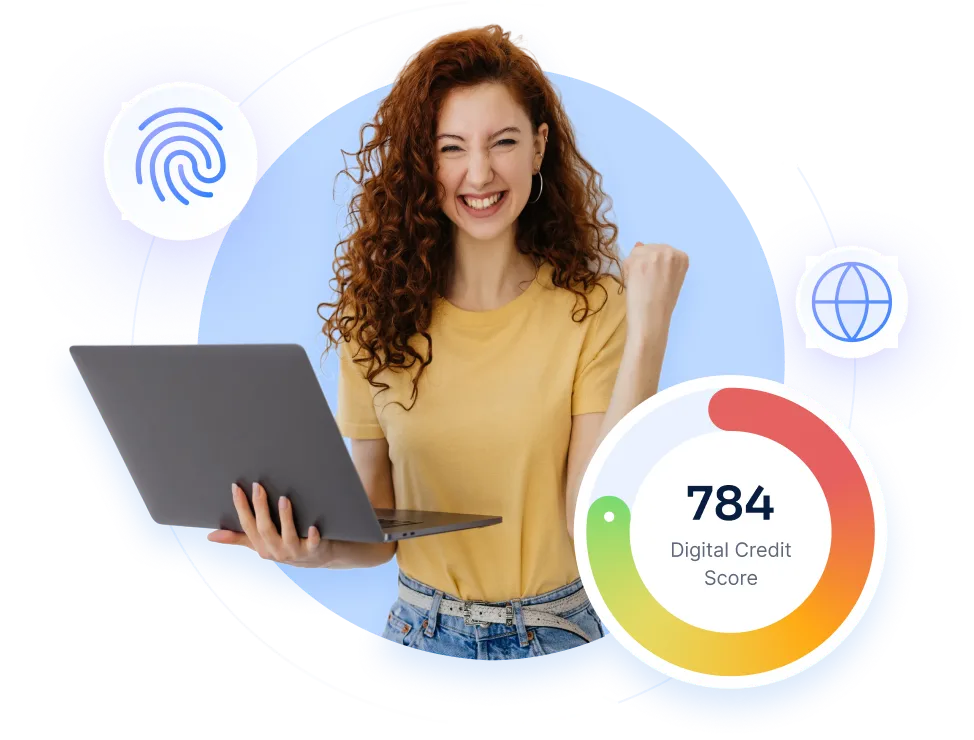Three Advanced Checks for Better Identity Verification in Lending
Learn how lenders can use face match, name match, and location match analyses to build inclusive financial systems.

Traditional credit scoring involves assessing potential borrowers based on their credit history.
However, there are about 1.4 billion unbanked people. This category of the population cannot count on receiving a loan in the traditional way.
To solve this issue, modern financial organizations should rely on alternative credit scoring, including digital footprint analysis that helps uncover non-obvious borrower risk factors.
In this article, we’ll talk about three non-obvious ways to find information – face match, name match, and location match analyses. Thanks to them, the RiskSeal platform helps credit companies build an inclusive financial system and enter emerging markets.
1. Face match: effective personal identification technology
Face match is a technology that allows you to compare several photographs and determine whether they depict the same person.

This approach to identity verification, based on advanced face recognition algorithms, is widely used in the credit industry. It helps promptly recognize scammers who want to assume the identity of another person.
This reduces the risk of issuing loans to borrowers who do not plan to repay them.
Face match implementation in RiskSeal
Face match technique is implemented in RiskSeal’s digital scoring system as follows:
1. Loan application. A potential borrower applies to a credit institution to obtain a loan.
During the application process, the borrower provides all the necessary data, including last name, first name, email address, and telephone number.
Some online lending platforms also require their customers to take a selfie.
2. Identity verification. Based on this information, the RiskSeal system finds the borrower’s accounts on social networks and other platforms and analyzes the avatars posted on them.
If the lender has provided a selfie of the potential client, it is also compared with images found on the Internet.

How is the comparison made?
The technology is based on facial biometrics, the analysis of various data points obtained from a photo of a potential borrower.
For example, the distance between the eyes, mouth, and nose, the shape of the cheekbones, lip contour, and other unique characteristics.
After a comparative analysis, the platform estimates the likelihood that all photos show the same person, improving overalls identity verification match rates in the lending process.
3. Risk assessment. The digital scoring system assigns a risk level to a potential borrower corresponding to the results of the verification.
If all the photos match, the level of trust in the client increases, as does the likelihood of a positive decision on their application.
Inconsistencies found in images, on the contrary, increase the risk of loan default, and the borrower is marked as suspicious.
2. Name match as a reliable method of fraud prevention
Name match is another check that allows credit institutions to increase the accuracy of the assessment of potential borrowers.
It consists of determining the equivalence of several names indicated in various sources.
Different names used by the same person may be considered a sign of falsification or data theft.
Therefore, this technology is widely used in the lending industry for due diligence of potential customers and fraud prevention.
Name match in RiskSeal
Name matching on the RiskSeal platform is carried out in several stages.
1. Borrower details. The lender provides RiskSeal with the first and last name of the potential borrower indicated in the loan application.
2. Name matching. Based on the data received, the scoring system finds all the names with which the borrower has signed themselves on various resources, e.g., Facebook, Instagram, WhatsApp, Google, LinkedIn, etc.

3. Name comparison. The system compares whether the same name is listed in different sources.
The advantage of RiskSeal is that the system takes into account the linguistic and cultural characteristics of the spelling of one name.
That is, we’ll define the options Helen - Ellen - Nelly - Elena as the same name.
The platform can also recognize Arabic letters, hieroglyphs, and the Cyrillic alphabet and compare them with names in the Latin alphabet.

3. Location match – geographic checks to reduce loan defaults
Location match is another technology that allows credit institutions to assess the reliability of a potential borrower.
It involves verifying and confirming the geographic location specified by the borrower during the loan application process.
These types of checks help reduce default rates.
Firstly, they help determine the correctness of the information provided by the borrower.
Secondly, assess the risks associated with a particular region of residence, including its economic conditions, regulatory environment, and the level of fraud in that area.
Location match in credit scoring with RiskSeal
The location match technology has been successfully implemented in RiskSeal’s digital scoring system.
Checking the location insights of the borrower works as follows:
1. Borrower information. The credit institution provides RiskSeal with the information of the potential borrower specified when applying for a loan. The data includes a person's first name, last name, home address, and IP address.
2. Location analysis. The digital scoring system analyzes the received information and supplements it with the location determined from the IP address lookup.

3. Trustworthiness assessment. RiskSeal compares data obtained from different sources and identifies inconsistencies in the specified locations.
Based on the comparison, the system concludes the trustworthiness of the potential client.
If all addresses belong to the same jurisdiction, this speaks in favor of the borrower. If there are significant differences in the addresses, it raises concerns. The more inconsistencies we observe, the more suspicious the borrower’s profile becomes.
4. Income and crime rate assessment. The capabilities of our scoring system are not limited to this. For some countries, we provide official statistics that help assess the degree of crime in the region and the standard of living of its population.
How RiskSeal improves the decision process for lending organizations
Clients who contacted RiskSeal note the positive results of cooperation:
1. Increase of approved loan applications. At RiskSeal, we provide clients with hundreds of data points, the existence of which is often unknown even to the lenders themselves.
This allows lending to unbanked and underbanked categories of the population. It is very important for developing markets where the percentage of such residents is quite large.
For example, there are about 28% in Nigeria, 22% in India, and more than 50% in Mexico.
Our research shows that credit scoring with RiskSeal can increase loan approval rates by 30%.
2. Reducing the risk of loan default. A comprehensive assessment of the creditworthiness of borrowers allows us to suspect the likelihood of default even at the stage of considering an application for a loan.
Lending organizations also save on debt collection and losses from non-payment in the future.
According to RiskSeal analysts, our digital scoring system allows lenders to reduce default by 15%.
3. Increasing the predictive power. Lenders we work with have seen an increase in the predictive power of their scoring models.
According to RiskSeal’s research, this approach to credit scoring allows lenders to achieve a Gini coefficient of 1.5-1.6.

Download Your Free Resource
Get a practical, easy-to-use reference packed with insights you can apply right away.

Download Your Free Resource
Get a practical, easy-to-use reference packed with insights you can apply right away.




FAQ
What is face match in the context of credit scoring?

Face match is a technology that allows lending companies to compare several photos and determine whether the same person is depicted in them.
How does RiskSeal implement face match?

After the lender provides RiskSeal with the data of a potential borrower, our solution searches for all their avatars on the Internet.
The platform compares the images found, adding the customer's selfie to the comparison if the lender has provided one.
After the analysis, the system generates a conclusion about the probability that all photos depict the same person. Depending on the results, it assigns a certain level of risk to it.
What is a name match in the credit industry?

Name match is a technology that allows you to establish the equivalence of several names indicated in various sources.
In the context of the credit industry, name matching is used to check the reliability of borrowers.
If one person is using different names, this may indicate fraudulent activity. Such borrowers are assigned a high-risk level and are less likely to receive a loan.
How does RiskSeal perform name matching for identity verification?

Matching names is one of the checks carried out by RiskSeal to assess the creditworthiness of borrowers.
The algorithm is as follows: the lender provides us with the information of the potential borrower, after which we search all accounts belonging to them, including social networks.
Next, we compare the names listed on various online platforms. Detected differences may indicate fraud.
What is location match, and why is it important in credit scoring?

Location match is a technology that allows you to check and confirm the geographic location specified by the borrower during the loan application process.
Its use in the credit industry makes it possible to verify the correctness of the information provided by the borrower and assess the risks associated with a certain region of their residence.
How does RiskSeal use IP address and device location for location matching?

RiskSeal receives information about the borrower from the lender, which includes IP address and device location.
We then compare this data with the applicant's home address indicated in the loan application and the locations identified from their digital footprint. A discrepancy between jurisdictions will indicate a high probability of fraud.

.svg)
.webp)




.webp)